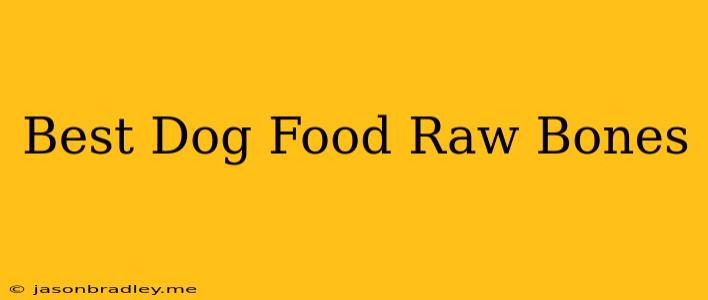Best Raw Bones for Dogs: A Guide to Safe and Nutritious Chewing
Raw bones are a popular treat for dogs, offering a natural source of calcium, phosphorus, and other essential nutrients. They also provide a satisfying chew experience that helps clean teeth and promote dental health. However, not all raw bones are created equal, and choosing the right ones for your dog is crucial to ensure their safety and well-being.
Here's a breakdown of the best raw bones for dogs, categorized by type and size:
Types of Raw Bones
1. Marrow Bones:
- Best for: Large breed dogs who love to gnaw.
- Pros: Rich in marrow, a highly nutritious substance.
- Cons: Can be messy, require supervision, and can splinter.
- Popular Choices: Beef, lamb, or veal marrow bones
2. Weight-Bearing Bones:
- Best for: All sizes of dogs, offering a good balance of chewability and strength.
- Pros: Durable, provide a longer chewing experience.
- Cons: Can be harder to break down, so choose a size appropriate for your dog.
- Popular Choices: Beef knuckle bones, femur bones, or ox tails
3. Rib Bones:
- Best for: Smaller dogs or puppies.
- Pros: Easier to break down, provide a satisfying chew.
- Cons: Can splinter, require careful supervision.
- Popular Choices: Lamb ribs, chicken ribs
4. Meat-Covered Bones:
- Best for: Dogs who prefer a more meaty chew.
- Pros: Offer a combination of bone and meat.
- Cons: May be more difficult to find, and the meat may go bad quickly.
- Popular Choices: Whole chicken wings, duck necks, pork necks
Choosing the Right Size
- Small Breed Dogs: Opt for smaller bones like lamb ribs or chicken wings.
- Medium Breed Dogs: Choose bones like beef knuckle bones or ox tails.
- Large Breed Dogs: Consider marrow bones, femur bones, or larger weight-bearing bones.
Safety Tips for Feeding Raw Bones
- Always supervise your dog while they are chewing on bones.
- Choose appropriate bone sizes to prevent choking hazards.
- Avoid giving cooked bones, as they can splinter and cause serious injuries.
- Remove any remaining bone fragments after your dog has finished chewing.
- Offer raw bones in moderation as part of a balanced diet.
- Consult your veterinarian for specific recommendations on the types of raw bones suitable for your dog's breed and age.
By following these guidelines, you can ensure that your dog enjoys the benefits of chewing raw bones safely and healthily. Remember, always prioritize your dog's well-being and consult with your veterinarian for any questions or concerns.
